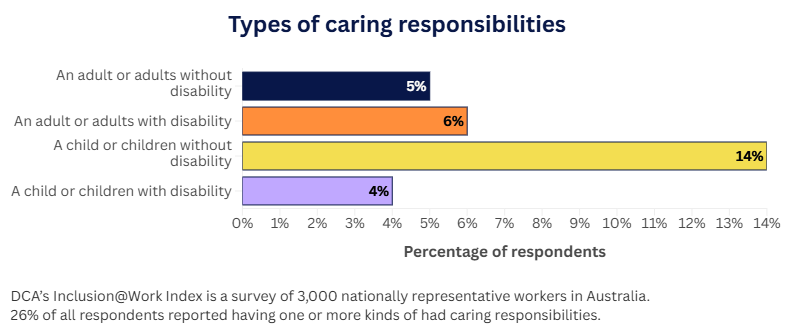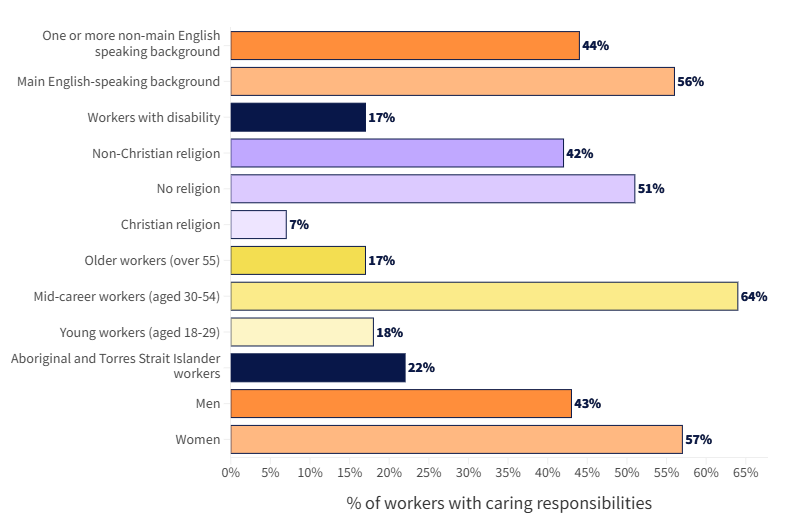- Fair Work Commission, “Family or carer’s responsibilities”, https://www.fwc.gov.au/family-or-carers-responsibilities.
- Australian Institute of Health and Welfare, “Informal Carers”, https://www.aihw.gov.au/reports/australias-welfare/informal-carers.
- Carers Australia, “Young Carers”, https://www.carersaustralia.com.au/about-carers/young-carers/.
- Jeffrey H. Greenhaus and Nicholas J. Beutell, “Sources of Conflict between Work and Family Roles,” The Academy of Management Review 10, no. 1 (1985): 76–88, https://doi.org/10.2307/258214.
- Jeffrey H. Greenhaus and Saroj Parasuraman, “The Allocation of Time to Work and Family Roles,” in Gender, Work Stress, and Health (American Psychological Association, 2002), https://doi.org/10.1037/10467-008.
- Australian Bureau of Statistics, “Statement of Regret: 2021 Census”, 14/08/2023, https://www.abs.gov.au/media-centre/media-statements/statement-regret-2021-census.
- Australian Bureau of Statistics, “Our families and households”, https://www.abs.gov.au/statistics/people/people-and-communities/snapshot-australia/latest-release#our-families-and-households.
- Australian Bureau of Statistics, “One parent families”, https://www.abs.gov.au/statistics/labour/employment-and-unemployment/labour-force-status-families/latest-release#one-parent-families.
- Australian Institute of Health and Welfare, “Child protection Australia 2023–24”, 25 June 2025, https://www.aihw.gov.au/reports/child-protection/child-protection-australia-2023-24/contents/insights/supporting-children#oohc.
- Australian Institute of Health and Welfare, “Child protection Australia 2023–24”, 25 June 2025, https://www.aihw.gov.au/reports/child-protection/child-protection-australia-2023-24/contents/insights/supporting-children.
- Australian Bureau of Statistics, “Labour Force Status of Families”, https://www.abs.gov.au/statistics/labour/employment-and-unemployment/labour-force-status-families/latest-release#key-statistics.
- Australian Institute of Family Studies, “Employment Patterns and Trends for Families with Children”, https://aifs.gov.au/research/research-reports/employment-patterns-and-trends-families-children.
- Australian Bureau of Statistics, “Barriers and Incentives to Labour Force Participation”, https://www.abs.gov.au/statistics/labour/employment-and-unemployment/barriers-and-incentives-labour-force-participation-australia/dec-2024.
- Australian Institute of Family Studies, “Employment of Men and Women Across the Life Course”, https://aifs.gov.au/research/facts-and-figures/employment-men-and-women-across-life-course.
- Carers Australia (J. Schirmer, M. Mylek, R. Miranti), Caring for Others and Yourself, 2022, https://www.carersaustralia.com.au/wp-content/uploads/2022/10/2022-CWS-Full-Report_221010_FINAL.pdf
- Elif Bahar et al., “Children and the Gender Earnings Gap: Evidence for Australia,” Economic Record 101, no. 332 (2025): 41–75, https://doi.org/10.1111/1475-4932.12834.
- Department of Prime Minister and Cabinet, National Strategy to Achieve Gender Equality - Discussion Paper: Women Bear the Burden of Care, https://www.pmc.gov.au/resources/national-strategy-achieve-gender-equality-discussion-paper/current-state/burden-care.
- Workplace Gender Equality Agency, WGEA Gender Equality Scorecard 2023-24, 20 November 2024, https://www.wgea.gov.au/publications/australias-gender-equality-scorecard.
- Australian Bureau of Statistics, “How Australians Use Their Time”, 7 October 2022, https://www.abs.gov.au/statistics/people/people-and-communities/how-australians-use-their-time/latest-release.
- Australian Institute of Family Studies, “Fathers and Work: A Statistical Overview”, May 2019, https://aifs.gov.au/research/research-snapshots/fathers-and-work-statistical-overview.
- Victorian Equal Opportunity & Human Rights Commission, “Parents and Carer Status”, https://www.humanrights.vic.gov.au/for-individuals/parent-and-carer-status/.
- Isaac Yeboah Addo et al., “Young Carers in Australia: Understanding Experiences of Caring and Support-Seeking Behaviour,” Australian Social Work 77, no. 1 (2024): 60–73, https://doi.org/10.1080/0312407X.2021.1971271.
- Ciara Smyth et al., “‘So That’s How I Found out I Was a Young Carer and That I Actually Had Been a Carer Most of My Life’. Identifying and Supporting Hidden Young Carers,” Journal of Youth Studies 14, no. 2 (2011): 145–60, https://doi.org/10.1080/13676261.2010.506524; Addo et al., “Young Carers in Australia.”
- Australian Seniors, “The Australian Seniors Series: Sandwich Generation Report 2025”, https://www.seniors.com.au/news-insights/the-australian-seniors-series-sandwich-generation-report-2025.
- Joan Acker, “Hierarchies, Jobs, Bodies: A Theory of Gendered Organizations,” Gender & Society 4, no. 2 (1990): 139–58, https://doi.org/10.1177/089124390004002002.
Ashlee Borgkvist, “‘It Would Be Silly to Stop Now and Go Part-Time’: Fathers and Flexible Working Arrangements in Australia,” in Engaged Fatherhood for Men, Families and Gender Equality: Healthcare, Social Policy, and Work Perspectives, ed. Marc Grau Grau et al. (Springer International Publishing, 2022), https://doi.org/10.1007/978-3-030-75645-1_13. - Acker, “Hierarchies, Jobs, Bodies.”
- “Forget about ‘the Ideal Worker’: A Theoretical Contribution to the Debate on Flexible Workplace Designs, Work/Life Conflict, and Opportunities for Gender Equality - ScienceDirect,” accessed July 29, 2025, https://www.sciencedirect.com/science/article/abs/pii/S0007681319300643?via%3Dihub.
- Shelley J. Correll et al., “Getting a Job: Is There a Motherhood Penalty?,” American Journal of Sociology 112, no. 5 (2007): 1297–339, https://doi.org/10.1086/511799.
- Borgkvist, “‘It Would Be Silly to Stop Now and Go Part-Time.’”
- The Australia Institute (R. Denniss, D. Baker), An Unhealthy Obsession? The Impact of Work Hours and Workplace Culture on Australia’s Health, November 2012, https://australiainstitute.org.au/wp-content/uploads/2020/12/IP11-An-unhealthy-obsession_4.pdf; L. Sander, “Go home on time! Working long hours increases your chance of having a stroke”, The Conversation, 28 June 2019, https://theconversation.com/go-home-on-time-working-long-hours-increases-your-chance-of-having-a-stroke-119388.


